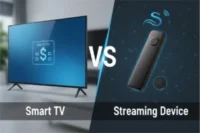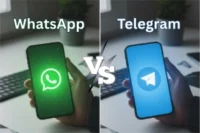Compare USB-C vs Lightning Connector: Speed, Power & Compatibility
Published: 1 May 2025
If you’ve ever fumbled in the dark trying to plug in your phone, you’ll appreciate the magic of today’s connectors—small, reversible, and surprisingly powerful. Two of the most common are USB-C and Lightning, found on everything from smartphones and tablets to headphones. USB-C has become the go-to for many Android devices and laptops, while Lightning remains exclusive to Apple products like iPhones and iPads.
While they may look similar, they differ in speed, power, and compatibility. And if you want to dive deeper into how USB standards themselves have evolved, my guide on the differences between USB 3.0 and USB 3.1 breaks it all down.
Understanding their differences will help you decide which one is more suitable for your device needs, especially when buying new gadgets or accessories.
Lightning Connector vs USB-C: Key Comparison
Let’s breakdown key differences of Lightning Connector vs USB-C in detail to know which is perfect to use:
1. Design and Shape
Let’s look at how both connectors differ in appearance and build.
USB-C:
- Oval-shaped and slightly larger than Lightning.
- Reversible design, so it can be plugged in either way.
- Designed to handle more power and faster data.
- Universal standard used across various devices.
- Made for durability with metal shielding.
Lightning:
- Slim and compact with a flat design.
- Also reversible for easy connection.
- Only compatible with Apple devices.
- Features exposed pins instead of internal contacts.
- Slightly more fragile due to its thinner structure.
2. Speed and Performance
Speed matters for charging and data transfer.
USB-C:
- Supports USB 3.1 and USB4 for faster data speeds.
- Can transfer data at up to 40 Gbps (USB4).
- Charges devices much faster due to higher power output.
- Supports fast charging protocols like Power Delivery (PD).
- Ideal for transferring large files like videos.
Lightning:
- Slower data transfer speeds (similar to USB 2.0).
- Maximum data speed is around 480 Mbps.
- Slower charging unless paired with a USB-C to Lightning cable.
- Limited support for newer fast charging standards.
- Suitable for basic use but not for heavy data transfer.
3. Compatibility and Usage
Both connectors are used in different ecosystems.
USB-C:
- Used in Android phones, tablets, laptops, and more.
- Found in modern devices from brands like Samsung, Google, and Dell.
- Compatible with many accessories and chargers.
- Allows one cable for multiple devices.
- Increasingly adopted as a universal standard.
Lightning:
- Only used in Apple devices (iPhones, iPads, AirPods).
- Requires special Lightning cables and accessories.
- Not compatible with non-Apple devices.
- Often needs adapters for wider use.
- Apple users are limited to a closed ecosystem.
4. Durability and Lifespan
Each connector type has a different level of strength and usage life.
USB-C:
- Built to handle 10,000+ insertion cycles.
- Stronger metal connectors offer more durability.
- Less likely to break or wear down quickly.
- Ideal for frequent use across multiple devices.
- Well-protected internal pins reduce damage risk.
Lightning:
- Also rated for 10,000 insertions but is more delicate.
- Pins are exposed and more prone to bending or corrosion.
- Can wear down faster with rough handling.
- Apple cables tend to fray or crack easily.
- Best with careful handling.
5. Cost and Availability
Let’s compare pricing and how easily each connector can be found.
USB-C:
- Widely available and usually more affordable.
- Many third-party cables and chargers are available.
- Doesn’t require brand-specific accessories.
- Easy to find at most electronics stores.
- More competition lowers overall cost.
Lightning:
- Typically more expensive due to Apple certification.
- Requires MFi (Made for iPhone) approval for third-party brands.
- Apple cables cost more than standard USB-C ones.
- Fewer options from third-party manufacturers.
- Not as easily available outside of Apple’s ecosystem.
✅ Quick Comparison Table: USB-C vs Lightning Connector
Here’s a quick comparison table of usb-c vs lightning connector for quick overview:
| Feature | USB-C | Lightning |
| Shape | Oval, reversible | Slim, reversible |
| Speed | Up to 40 Gbps (USB4) | Around 480 Mbps |
| Charging | Fast Charging supported (PD) | Limited fast charging |
| Compatibility | Used by many brands | Apple-only |
| Durability | More durable, metal contacts | Less durable, exposed pins |
| Availability | Widely available and cheaper | Costlier, Apple-certified only |
Which Is Better: USB-C or Lightning?
USB-C is better in terms of speed, power, compatibility, and future readiness. It works with more devices, charges faster, and transfers data more quickly. Lightning is still good for Apple users, but it’s limited and slowly being phased out. So if you want a connector that works with a variety of modern gadgets and lasts longer, USB-C is the better option overall.
Conclusion
USB-C and Lightning connectors each have their own advantages. USB-C is widely used, faster, and supports more power, making it a future-proof option for most tech users. Lightning, while slim and reliable, is limited to Apple devices and has slower data speeds. For Apple users, Lightning is necessary, but USB-C is better for those who want speed, power, and broader compatibility.
As technology evolves, USB-C is becoming the standard connector worldwide. Choosing the right connector depends on your devices, but USB-C is clearly more versatile and long-lasting for modern needs. And if you’re also exploring how your devices get their power, my guide on the differences between wired and wireless chargers is a great next read.
✅ FAQs about USB-C and Lightning Connector
Here are some of the most FAQs related to USB-C vs Lightning Connector:
Only if you use a USB-C to Lightning cable. iPhones don’t have a USB-C port yet (except for newer models like iPhone 15).
Yes, USB-C supports faster charging due to higher power delivery, especially when paired with the right adapter.
Apple uses Lightning for its ecosystem control and accessories, though they are slowly shifting to USB-C in newer devices.
Yes, most USB-C cables are safe, but always choose certified and good-quality cables to avoid damage.
Yes, USB-C is used widely on laptops, Android phones, and many modern devices, making it very versatile.
USB-C generally lasts longer due to its solid build and internal pins that are better protected.
No, Lightning cables are limited to USB 2.0 speeds, which are slower than USB-C options.
Yes, starting with iPhone 15, Apple is slowly transitioning to USB-C due to global regulations and user demand.
Only if your AirPods case supports USB-C input, otherwise, you’ll need a Lightning cable.
Power Delivery is a fast-charging feature supported by USB-C that allows much faster and safer charging for devices.

- Be Respectful
- Stay Relevant
- Stay Positive
- True Feedback
- Encourage Discussion
- Avoid Spamming
- No Fake News
- Don't Copy-Paste
- No Personal Attacks

- Be Respectful
- Stay Relevant
- Stay Positive
- True Feedback
- Encourage Discussion
- Avoid Spamming
- No Fake News
- Don't Copy-Paste
- No Personal Attacks





